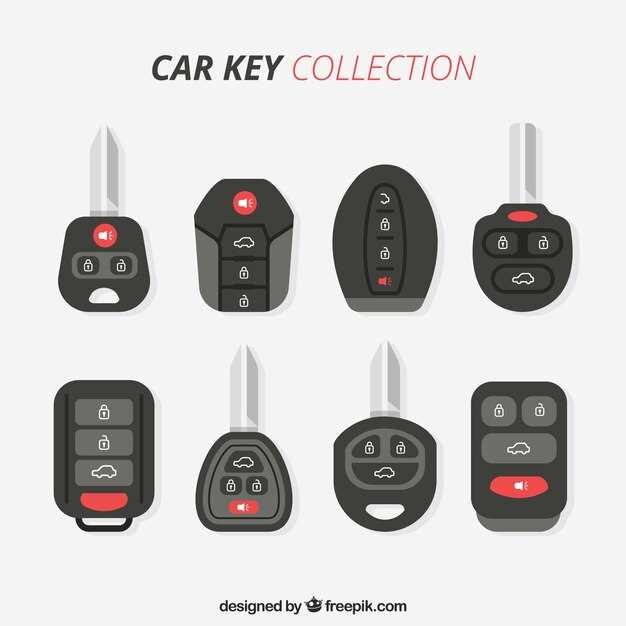
In today’s evolving automotive landscape, the concept of smart keys has transformed the way we interact with vehicles. Unlike traditional keys that require physical insertion and turning, modern keyless entry systems allow drivers to unlock and start their cars with just a push of a button or a simple presence detection. This seamless integration of technology enhances convenience and security for vehicle owners.
At the core of smart key systems is a crucial functionality that sets them apart: the ability to communicate wirelessly with the vehicle. When a smart key is within proximity, it transmits a unique signal, enabling the vehicle’s sensors to recognize it and allow entry without traditional unlocking methods. This innovation not only streamlines the entry process but also reduces the risk of key theft, as it requires sophisticated encryption to function.
As we delve deeper into the workings of smart keys, it becomes evident that their benefits extend beyond mere convenience. Understanding their functionality can help users appreciate the technology’s role in enhancing vehicle security and user experience. From proximity detection to remote start capabilities, smart keys are redefining how we interact with our vehicles in an increasingly keyless world.
How Keyless Entry Systems Work in Modern Vehicles
Keyless entry systems have revolutionized the way we access and operate our vehicles. These systems utilize advanced technology to provide convenience and enhance security. Below is an overview of how these systems function in modern vehicles.
Keyless entry systems typically operate using a smart key or key fob that communicates with the vehicle’s electronic control unit (ECU) through wireless signals. Here are the core components and their functionalities:
- Smart Key: This device generates a unique code that is transmitted to the vehicle when in close proximity. The vehicle recognizes this code and allows entry.
- Proximity Sensors: These sensors detect the presence of the smart key nearby. When the key is within range, the vehicle will automatically unlock its doors.
- RFID or Bluetooth Technology: Most keyless systems use Radio Frequency Identification (RFID) or Bluetooth communication to facilitate a secure connection between the smart key and the vehicle.
The process of using a keyless entry system is straightforward:
- Car Approach: As the driver approaches the vehicle with the smart key, the proximity sensors initiate communication.
- Door Unlocking: Upon recognizing the smart key, the system automatically unlocks the doors, providing seamless access.
- Engine Start: To start the vehicle, the driver simply needs to press the start button, provided the smart key is inside or nearby.
Modern vehicles also incorporate safety features to prevent unauthorized access:
- Encryption: The transmission of signals between the smart key and the vehicle is encrypted, making it difficult for potential thieves to intercept.
- Rolling Codes: Each time the smart key is used, a new code is generated, further enhancing security and preventing code duplication.
In summary, keyless entry systems enhance both accessibility and security in modern vehicles. By utilizing smart key technology and advanced communication methods, these systems facilitate effortless vehicle access while safeguarding against unauthorized entry.
Common Issues with Smart Keys and Troubleshooting Tips

Smart keys are designed to enhance convenience and security, but various issues can arise that may hinder their functionality. Understanding these common problems can help users effectively troubleshoot and resolve them.
One prevalent issue with keyless entry systems is a weak or dead battery in the smart key. If the vehicle fails to recognize the key when approaching or attempts to start, the first step is to check the battery status. Replacing the battery in the smart key usually resolves this issue, restoring the ability to access and start the vehicle.
Another frequent problem occurs when the smart key loses its programmed connection to the vehicle. This can happen after a battery replacement or due to interference from other electronic devices. If the key does not respond, users should consult the vehicle’s manual for reprogramming instructions, or visit a dealership for assistance.
Environmental factors can also affect smart key performance. Extreme temperatures, moisture, and interference from nearby electronic devices may hinder the functionality of keyless entry. To mitigate these issues, it’s advisable to keep the smart key away from potential sources of interference and store it in a cool, dry place.
Sometimes, users may experience difficulty due to a malfunctioning or damaged key fob. Physical damage to the key can prevent it from communicating with the vehicle. In these cases, inspecting the fob for cracks or signs of wear and considering a replacement may be necessary.
Lastly, outdated software in the vehicle’s system might lead to connectivity issues with smart keys. Regularly updating the vehicle’s software can improve compatibility and resolve problems with keyless entry. Vehicle owners should check with the manufacturer for any available updates or recalls related to their smart key system.
By understanding these common issues and implementing the appropriate troubleshooting steps, users can ensure their smart keys function effectively, providing seamless access and convenience.
Benefits of Upgrading to a Smart Key System

Upgrading to a smart key system offers numerous advantages that enhance security and convenience for users. One of the primary benefits is the keyless entry feature, which eliminates the need for traditional keys. This means you can access your vehicle or property without fumbling for a key, especially in adverse weather conditions or when your hands are full.
Additionally, smart keys often include advanced security measures. Many systems are equipped with encryption technology that makes it significantly more difficult for thieves to duplicate or hack your key. This increased security can provide peace of mind, knowing that your vehicle or home is better protected against unauthorized access.
Another notable benefit is the convenience of managing multiple access points through a single device. With a smart key, users can control various locks within a property or even multiple vehicles with ease. This integrated approach streamlines the process of access management and reduces the likelihood of losing track of physical keys.
Smart key systems also allow for additional features such as remote unlocking, tracking, and even alerts when someone attempts to access your property without permission. These functionalities create a more comprehensive security solution that adapts to modern needs.
Finally, the smart technology embedded in these keys often comes with mobile app compatibility, enabling users to monitor their access settings in real time. This level of control not only enhances security but also contributes to a more user-friendly experience.




